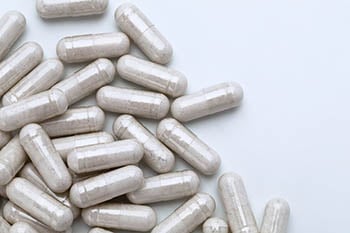A 5-Minute Guide: Quercetin’s Health and Immune System Benefits
DISCLAIMER:This blog does not intend to provide diagnosis...
- In this article:
- What is Quercetin?
- 4 Health Benefits of Quercetin
- Clinical Studies of Quercetin, Athletic Performance, and Immunity
- Quercetin, Zinc, and Synergy with Vitamin C
- The Question of Absorption of Quercetin
- Quercetin: Dosage Considerations
- Quercetin: Safety and Drug Interactions

What is Quercetin?
Quercetin has received a lot of attention recently due to scientific studies of its effects on immune system health. Specifically for its action on promoting enhanced immunity to the respiratory tract and its role in amplifying some of the antiviral effects of zinc.
Quercetin is a flavonoid, a group of plant pigments largely responsible for the colors of many fruits and flowers. Flavonoids are also responsible for the health benefits of many foods, herbs, and spices. For example, the beneficial effects of berries, dark chocolate, and the majority of herbal extracts (e.g., ginkgo, grapeseed, pine bark, milk thistle, etc.) are now known to be directly related to their flavonoid content.
4 Health Benefits of Quercetin
Flavonoids possess an incredible ability to enhance the body’s reaction to environmental and other biological challenges. Quercetin is consistently the most active of the flavonoids in experimental studies making it the best choice when the body is dealing with increased challenges.
1. Quercetin May Help Protect Our Cells
Quercetin literally can act as an “on switch” to promote some beneficial effects within cells such as promoting cellular repair while simultaneously acting as an “off switch” in helping cells protect themselves from damage or infection.
2. Quercetin May Have Potent Antioxidant Properties
Quercetin possesses significant antioxidant effects and enhances the body’s antioxidant system of enzymes to support the body during times of biological stress (immune activation, inflammation, and allergies).
3. Quercetin May Help Reduce Inflammation
Quercetin inhibits both the manufacture and release of compounds known as inflammatory mediators that aggravate the body’s attempt to balance inflammation.
4. Quercetin May Help Boost Immunity
Quercetin has special effects on immune system health and may help promote enhanced immunity to the respiratory tract. In fact, there has been a lot of attention on quercetin recently because of its effects on immune function as well as its ability to increase the intracellular level of ionic zinc. In its free ionic state, zinc inhibits an enzyme known as replicase that viruses use to replicate within human cells. Quercetin facilitates the transfer of ionic zinc into cells through channels known as ionophores.
Clinical Studies of Quercetin, Athletic Performance, and Immunity
One of the most scientifically investigated applications of quercetin is supporting optimal athletic performance.
In over a dozen clinical trials, quercetin has been shown to have a slight effect in improving athletic performance. For example, in one study of eleven elite male cyclists, 6 weeks of quercetin supplementation (1,000 mg per day) improved a 30-kilometer time-trial performance by 3.1%.1 In elite athletes, this small improvement can be quite significant.
Another study in cyclists produced somewhat of a surprise discovery. In the study, 40 trained male cyclists received quercetin (1,000 mg per day) or placebo before, during, and 2 weeks after a 3-day period in which the subjects cycled for 3 hours a day at approximately 57% maximal workload. Not only did the quercetin improve physical performance, but results showed something else.
During the 14-day period after the 3 days of intensified exercise, only 1 of the 20 cyclists given quercetin developed upper respiratory tract congestion and other symptoms while, in comparison, 9 of 20 in the placebo group displayed respiratory tract symptoms.2
The results were really not all that surprising. Quercetin possesses a number of beneficial effects on white blood cell function and exerts some protection against respiratory tract viruses. It can help white blood cells move to areas of need and increase their ability to destroy foreign molecules. Quercetin in cell cultures has shown that it reduced the infectivity of human cells by a number of different types of viruses as well as reducing the rate of viral replication through various pathways.3
This surprising discovery led to a follow-up trial in 1,002 adults from 18 to 85 years of age.4 The purpose was to measure the influence of two different doses of quercetin (500 and 1000 mg/day) compared to placebo on symptoms of a cold or upper respiratory tract infection (URTI).
The subjects ingested the supplements for 12 weeks and logged URTI symptoms on a daily basis. No significant overall effect was noted, but when they looked at group differences they found in subjects 40 years of age and older rating themselves physically fit, taking 1,000 mg of quercetin per day showed a 36% reduction in respiratory tract symptoms and 31% reduction in total sick days compared to the matched placebo group.
These results indicate that at a dosage of 1,000 mg per day quercetin may exert some benefit at improving immune function. It is possible that higher dosages or use of quercetin preparations that are more bioavailable may be required to show benefit in other groups.
Quercetin, Zinc, and Synergy with Vitamin C
Although quercetin has some direct effects that protect against viral infection, its major effect maybe by acting as what is known as an ionophore in aiding the transport of free, unbound zinc into cells.
In its free, ionic state zinc can inhibit the replication of many viruses. When many viruses infect a cell, it inserts a piece of its genetic code and an enzyme called replicase to allow the virus to replicate. Zinc is able to block the replicase enzyme and, therefore, block the replication or spread of the virus. That is one of the reasons zinc is a popular recommendation against the common cold.
In order for zinc to have this effect on viral replicase, however, it is dependent upon an open “ionophore” - a special cell membrane channel that allows for an ion to enter the cell. Quercetin can act as a zinc ionophore to increase the levels of ionic zinc within cells to protect against viral replication. This effect of quercetin may explain the decreased number of respiratory tract infections noted in the studies described above.5
Another partner nutrient for quercetin is vitamin C. When vitamin C and quercetin are combined in test tube studies, their immune-enhancing and antiviral actions work synergistically to produce better results than when either is added alone.6
Vitamin C is also able to regenerate active quercetin in the body. Whenever an antioxidant performs its function in neutralizing a free radical, it is changed to an inactive form. In the case of quercetin, vitamin C is able to recycle it back into its active form. It is therefore very important that vitamin C levels in the diet and through supplementation is adequate.
In addition to eating high vitamin C containing foods on a regular basis (fruit such as berries, citrus, and mangoes; green leafy vegetables; broccoli; bell peppers; etc.) supplementing with additional vitamin C is also recommended (a minimum of 60 mg per day, but for optimal support at least 250 mg).
The Question of Absorption of Quercetin
In human absorption studies, quercetin has been shown to be poorly absorbed with a high degree of variability from one person to the next.
To address the issue of poor absorption of quercetin, one innovative solution involves complexing quercetin within a LipoMicel Matrix™. This new technology utilizes a unique process that enhances the absorption of quercetin by as much as 10 times compared to regular quercetin powder.
What is a Liposome?
Liposomes are cells composed of two layers of fatty molecules that protect an inner compartment composed of water and water-soluble active ingredients. The water-soluble ingredient, like vitamin C for example, is protected within the inner compartment by the liposomal structure.
Liposomes of quercetin are not possible because quercetin is not water-soluble, but that turns out to make quercetin a perfect candidate for the use of technology that creates the LipoMicel Matrix™.
What is a Micelle?
Micelles differ from liposomes in that they are “inside-out” compared to liposomes. Specifically, the fatty substances that create a micelle have a water-loving (hydrophilic) “head” on its outer layer and fat-loving (fat-loving) “tail” on the inside.
Quercetin in the LipoMicel Matrix™ solves the issue of quercetin not being soluble in water. Since quercetin is fat-loving, during the process of creating the LipoMicel Matrix™ it becomes held in place by the tail of the fatty molecules within the center of the micelle. The micelles that are formed are so small, the quercetin within the LipoMicel Matrix™ becomes mixable in water. In fact, if you squeeze the contents of a soft-gel containing Natural Factors’ Quercetin LipoMicel Matrix™ into a glass of water it mixes easily. Micelles are often used to create “nanoemulsions,” which are mixtures of normally unmixable forms like oil and water or in this case quercetin and water.
Quercetin: Dosage Considerations
As described above, regular quercetin is poorly absorbed because it is not soluble in water. Nonetheless, there are some benefits noted in clinical trials at a dosage of 1,000 mg per day.
That said, in looking at the scientific literature, a better-absorbed form of quercetin that produces more consistent and higher blood levels may provide superior results.
The dosage for the Natural Factors’ Quercetin LipoMicel Matrix™ is 250 to 500 mg per day. Each soft-gel capsule contains 250 mg of quercetin within the LipoMicel Matrix™. Preliminary absorption data indicate a 5 to 10-fold greater absorption for this advanced form over regular quercetin. This indicates that each capsule of Quercetin LipoMicel Matrix™ would have a bioequivalence of 1,250 to 2,500 to regular quercetin powder. If two capsules are taken daily that bioequivalence increases to 2,500 to 5,000 mg of regular quercetin.
Quercetin: Safety and Drug Interactions
All forms of quercetin are well tolerated in humans with no side effects noted in the clinical studies or expected even with increasing dosage.
It is important to point out that quercetin may enhance the uptake from the intestine of certain drugs, including vinblastine, cyclosporine, digoxin, fexofenadine, losartan, nifedipine, felodipine, verapamil, and terfenadine. Dosage of these drugs may have to be reduced to avoid toxicity.
It is always important to consult with your doctor first for proper monitoring before making changes to your diet or routine.
References:
- MacRae HS, Mefferd KM. Dietary antioxidant supplementation combined with quercetin improves cycling time trial performance. Int J Sport Nutr Exerc Metab. 2006;16(4):405-419.
- Li Y, Yao J, Han C, et al. Quercetin, Inflammation and Immunity. Nutrients. 2016;8(3):167.
- Nieman DC, Henson DA, Gross SJ, et al. Quercetin reduces illness but not immune perturbations after intensive exercise. Med Sci Sports Exerc 2007;39;1561–1569.
- Heinz SA, Henson DA, Austin MD, et al. Quercetin supplementation and upper respiratory tract infection: a randomized community clinical trial. Pharmacol Res 2010;62:237–242.
- Dabbagh-Bazarbachi H, Clergeaud G, Quesada IM, et al. Zinc ionophore activity of quercetin and epigallocatechin-gallate: from Hepa 1-6 cells to a liposome model. J Agric Food Chem. 2014 Aug 13;62(32):8085-93.
- Colunga Biancatelli RML, Berrill M, Catravas JD, Marik PE. Quercetin and Vitamin C: An Experimental, Synergistic Therapy for the Prevention and Treatment of SARS-CoV-2 Related Disease (COVID-19). Front Immunol. 2020;11:1451.
- Riva A, Vitale JA, Belcaro G, et al. Quercetin phytosome® in triathlon athletes: a pilot registry study. Minerva Med. 2018 Aug;109(4):285-289.
- Kawai Y. Understanding metabolic conversions and molecular actions of flavonoids in vivo:toward new strategies for effective utilization of natural polyphenols in human health. J Med Invest. 2018;65(3.4):162-165.

 By Dr. Michael Murray, N.D.
By Dr. Michael Murray, N.D. 


